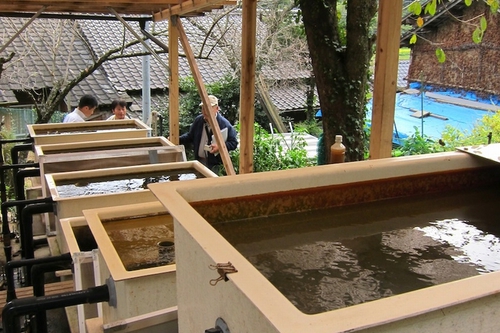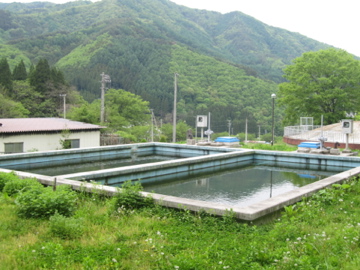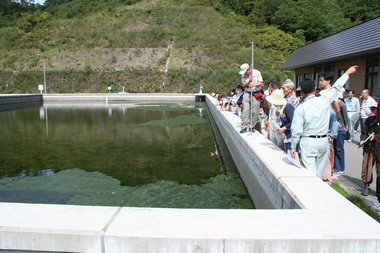December 10, 2013
Let's Bring about Real Change to Water Supply Infrastructure! Taking Another Look at Ecological Purification Systems
Keywords: Newsletter Water
JFS Newsletter No.135 (November 2013)
 Small-scale ecological water purification units in Kurotsuchi,
Small-scale ecological water purification units in Kurotsuchi,
Bungotakada City, Oita Prefecture
Copyright Junji Hashimoto All Rights Reserved.
After the Great East Japan Earthquake in March 2011, we in Japan faced an enormous challenge getting a secure supply of electricity, but did you know that securing safe water was an issue as well? Nowadays, small-scale, decentralized energy has attracted the public's attention. But what about water security? How about the idea of decentralization and small-scale approaches for water resources too?
Courtesy of a Japanese non-profit organization named Think the Earth, dedicated to "ecology and economy in coexistence," here we present an adaptation of an article about water purification systems, posted on their website, Think Daily.
------------------------
Japanese society has evolved with a fixation on achieving efficiency by centralizing and expanding in scale. But the Great East Japan Earthquake has brought the disadvantages of such ways to light. Experiences from the disaster started people thinking about decentralization and energy on a smaller scale.
People are starting to realize that it may also be necessary to start thinking about water in the same way. We need make a shift towards "safe," "low cost," and "energy-saving" water systems. This shift is essential for realizing sustainable, small-scale communities. Specifically, we need to reexamine the sources of our water, how we purify it, and how wastewater is processed. In this report, we take a closer look at the ecological purification of water (slow sand filtration), which has begun to draw attention in Japan after the earthquake.
Water Supply and Sewage Systems Use Enormous Amounts of Electricity
The magnitude 9.0 earthquake that struck Japan on March 11 and the subsequent tsunami had a devastating effect on our infrastructure including the water supply, which is a vital lifeline. About 2.2 million homes went without water, mainly in Iwate, Miyagi, Fukushima, Ibaraki, and Chiba prefectures. The water pipes were destroyed and water flooded the streets. The ground near water treatment plants shifted downward and water reservoirs were destroyed. Many water treatment plants lost their power supply and could not operate. We realized that in order to have water, we needed electricity.
Today's Water Infrastructure Requires Energy
A lot of energy is required to supply water and treat sewage. In Japan, approximately 7.9 billion kWh of electricity is needed each year to transport water from the source, purify it, and supply it to people's homes. Likewise, to collect wastewater, process it, and release the discharge consume 7.1 billion kWh each year. Together, water supply and treatment in Japan consumes 15 billion kWh each year, equivalent to the total energy generated by 1.5 nuclear reactors.
Here are three main ways to filter water (in order of high to low energy efficiency): slow sand filtration, rapid sand filtration, and membrane filtration.
Ecological Purification Systems Are Safe, Low Cost, and Energy Saving
We spoke to Mr. Nobutada Nakamoto (chairman of the Community Water Supply Support Center of Japan and professor emeritus of Shinshu University), an expert in slow sand filtration.
"Slow sand filtration has been around for a very long time. Water becomes purified as it slowly runs through the sand. Actually, organisms invisible to the naked eye found on the surface of the top filtration layer purify the water. They work quite fast; they are not at all slow. So calling the system an "ecological purification system" would describe it better.
This method, which uses nature rather than chemicals, is a compact representation of how the soil in the forest purifies water.
Even immediately after the earthquake/tsunami struck, water treatment plants that treated water using an ecological purification system (slow sand filtration method) were able to continue supplying safe drinking water.
Why? Because they have a simple and durable structure, do not require electricity to treat water, and don't need any chemicals other than chlorine. Even under difficult circumstances, the water treatment plants managed to maintain their usual operations."
Disadvantages of Rapid Sand Filtration
The most prevalent purification method today is rapid sand filtration. Initially, most water treatment plants used ecological purification systems, but after the war many water treatment plants switched to rapid sand filtration.
Rapid sand filtration can make large quantities of water very rapidly by using chemicals (flocculation agents) to sink contaminants in the water to the bottom, and filtering the water on the upper surface using pebbles and sand.
There are disadvantages to such "large scale" and "centralized" purification facilities. The process cannot remove water-soluble organic matter and ammonia, so you need to kill bacteria using chlorine. Moreover, it also cannot remove thing like manganese, odor, and synthetic detergents, so the treated water does not taste as good.
That is municipalities in metropolitan areas such as Tokyo began incorporating additional processes for piped water such as ozone treatment and activated carbon water treatment -- to get rid of substances that cause moldy smells or the smell of chlorine -- things that rapid sand filtration cannot remove.
In the past, water was sometimes polluted by protozoa called cryptosporidium, which can cause outbreaks of diarrhea. Cryptosporidium cannot be killed with chlorine, so the use of membrane filtration (which uses a filter with micro pores that removes turbidity and contaminants from raw water) was recommended.
Mr. Nakamoto explains, "By shifting from ecological purification to rapid sand filtration, we were able to meet the rapid increase in water demand with large-scale, centralized water treatment plants. And the maintenance and management could also be automated. But on the other hand, issues with mold and cryptosporidium pollution is a technological "loop hole" associated with rapid sand filtration. We would not have had to face such issues had we stuck with ecological purification."
New processes were introduced such as activated carbon water treatment, ozone treatment, and membrane filtration, to address these technological issues. But these processes required more capital investment, increased costs of consumables, and more energy, so financing became very difficult. In principle, the cost of water is divided among the number of users, so the smaller the community, the more expensive the cost of using water.
A Town That Implemented Ecological Purification System as a Measure against Protozoa
In 1997, the Tetta Town (currently known as Niimi City), Okayama Prefecture received notice from the water quality inspection agency that cryptosporidium (protozoa) or something of the like was found in the water. The Ministry of Health and Welfare (now Ministry of Health, Labour and Welfare) issued an immediate directive to cease supplying water and to purify the water.
Tetta was blessed with water of such great quality, they actually didn't really need a purification facility. But because of this problem, they had to establish a new water treatment plant to supply water. Many meetings were held in town. In the end, to supply "safe, tasty, water, inexpensively," they decided to build an ecological purification system (slow sand filtration).
The Ministry of Health and Welfare accepted all three filtration methods - rapid sand filtration, slow sand filtration, and membrane filtration - as a measure against cryptosporidium, but it initially only provided subsidies to plants that chose to use membrane filtration (later, it was decided to provide subsidies to all methods).
But the town of Tetta still chose to implement the ecological purification system (slow sand filtration). This choice was because the construction, maintenance, and management costs were low. Also, with rapid sand filtration, which needed to use significantly more chlorine than in the past, they thought that there would be higher health risks for the residents.
Kenzaki Water Treatment Plant
The Kenzaki water treatment plant located in Takasaki City, Gunma Prefecture, is the oldest water plant in Takasaki, erected in 1910. Water treatment plants that employ ecological purification have a very simple and robust structure. In fact, plants built during the Meiji (1868-1912) and Taisho (1912-1926) eras are still in operation.
The Kenzaki water treatment plant transports water from the Kasuga barrage dam on the Karasugawa River, in the town of Haruna, Gunma Prefecture, using the difference in elevation of the land. It does not require the use of energy to source water, so it is really an ideal plant.
Maintenance-free Nishihara Water Treatment Plant
When an ecological purification system is managed properly, it hardly requires any maintenance except for the occasional removal of algae and sludge from the sand filtration tank.
The Nishihara water treatment plant in Suzaka City, Nagano Prefecture, uses an ecological water purification system. It is a small, unmanned water treatment plant located in the middle of a grassy field. The only electronic device you will find here is a meter. Not only does it not need maintenance equipment, it does not even require plant management. The plant began operation in 2004, and no maintenance work has been needed since then.
Mr. Nakamoto explains, "What is important with ecological water purification is to create a proper environment where the biotic community can do its work. As long as you do that, you don't have to do much else. Because the term, "slow sand filtration" is widely recognized, people think water must be filtered slowly, and that the amount of water this filtration method can provide is limited. This is not necessarily true. If you look at water flowing through nature, the flow could be quite rapid, but clear water still gushes from the wellspring.
In fact, what is important is that you don't change the speed at which the water flows. Even if it is fast, if the flow is constant, the biological community will remain active."
 Nishihara Water Treatment Plant
Nishihara Water Treatment Plant
Copyright Junji Hashimoto All Rights Reserved.
Ecological Purification Systems Are Being Reexamined in Various Regions across Japan
Many people have begun to reexamine the idea of the ecological water purification system because it is safe, costs little, and saves energy.
The Nishino water treatment plant in Mihara City, Hiroshima Prefecture, used to use both rapid sand filtration and ecological water purification, but in 2004, a complete shift was made to ecological water purification. Misato Town of Miyagi Prefecture used to have rapid sand filtration to supplement its water treatment, but the aging system needed renovation, so the town implemented a new system, heeding the voices of residents in 2008. The key benefits that helped make this decision were the system's ability to make good water at low cost.
Irabu Island in Okinawa Prefecture already used the ecological water purification method in the past, but later installed rapid sand filtration and membrane filtration. This resulted in huge costs and excessive debt. But when the island merged its administration with Miyako City, decided to continue the membrane filtration and to restart the shuttered ecological purification system.
 Nishino water treatment plant
Nishino water treatment plant
Copyright Junji Hashimoto All Rights Reserved.
Slow Sand Filtration System Saved Marginal Settlements
The mountain valleys in Oita Prefecture are the home of several marginal settlements with only a dozen or so residents. No network of water pipes reaches these settlements, so the residents have relied on water from shallow wells since long ago. But in recent years, the water tested positive for iron, manganese, and bacteria, so the water was deemed to be no longer fit for drinking. However, it is financially difficult to construct pipes all the way to these small settlements. The solution was to set up ecological water purification units by placing stones and sand into metal containers to filter the well water, and to let the biological community go to work and create clean water. (See photo at the top.)
Now they can supply safe drinking water at the low cost of a little over a thousand dollars. They are gathering a wealth of data right now, and are considering selling this type of equipment soon as they have confirmed stable operations.
We use water from the tap without really giving it much thought, but a lot of cost and energy goes into supplying the water. It is important to keep down costs and energy consumption, while providing continuous supply of safe drinking water. The cases described here show that ecological purification systems are a key technology for making the shift towards "safe," "low cost," and "energy saving" water supplies.
Written by Junji Hashimoto Journalist specializing in water issues
------------------------
In June 2014, the fifth International Slow Sand and Alternative Biological Filtration Conference will be held in Nagoya, Japan.
http://5ssabc.jp/en/index.html
We will keep an eye on future developments of ecological purification systems as a key technology for safe water supply.
Adaptation from Think Daily by Think the Earth.
The full text is available here.
Let's bring about real changes to the water supply infrastructure! Taking another look at ecological purification systems
http://www.thinktheearth.net/thinkdaily/report/2011/09/rpt-58.html#page-1
